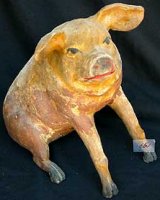A Brief & Colorful History of the Piggybank: How to Save Money & Spread Good Luck!
by SixWise.com
Piggybanks have become a timeless icon in America-something that people
of all ages recognize and enjoy. Many people still remember their childhood
piggybanks, and they continue to be a popular baby gift today (see our
recommendation below). As familiar as piggybanks are to Americans, did
you ever wonder why and how saving your money in a replica of a pig become
popular?
|

A vintage pottery piggybank made in Mexico in the 1940s.
|
Their history is actually quite serendipitous. In the mid-1500s when
metal was too scarce and expensive to be widely used, household pots and
jars were made out of clay. The commonly used variety was an orange clay
called "pygg." Families would collect any spare coins in these
"pygg" jars that eventually came to be known as pygg banks.
Later, around the 18th century, potters and local craftsman were often
asked to create pygg banks and by that time the word sounded just like
the word for the animal "pig." Either a creative potter had
a whimsical idea to shape the "pygg" bank like a pig, or one
of them misunderstood the request and shaped the bank like a pig by mistake.
The trend caught on and soon adults and children throughout Europe wanted
a piggy bank of their own. The first varieties were ceramic and had no
hole on the bottom so in order to retrieve any coins the bank had to be
broken. Someone later came up with the bright idea of adding a hole so
coins could be taken out without destroying the bank.
Americans and Europeans are not the only ones who cherish piggybanks.
South Americans, Asians and Africans also have their own varieties, each
surrounded by their own traditions.
-
America: Piggybanks are given to children to encourage saving
money.
-
China: Piggybanks are considered a lucky charm for children
that encourage them to save money.
-
Europe: Piggybanks are given to children and adults and are
thought to bring good luck and financial good fortune.
-
Germanic Countries: "Lucky Pigs" are given as gifts
at the start of the New Year.
|

The Money Savvy Pig is THE educational award-winning piggybank
for today's money savvy child. Give them the good financial luck
traditionally associated with a piggybank, and help them learn money-management
skills while they are young!
Read
More Now.
Ranked "One of the Best Products of the Year,"
by USA Today, the Money Savvy Pig challenges kids to make responsible
choices with their money, giving them a gift that will last a lifetime:
An education in smart money management! Now
available at SixWise.com!
|
Today piggybanks have become highly collectible and some of the vintage
varieties are valued at hundreds of dollars. A new variety, the Money
Savvy Pig, has also been making headlines in Time magazine and USA Today
as a simple but remarkably effective way to teach kids basic money management
skills. How does it work? It has four chambers (one each for saving, donating,
spending and investing, which is clearly listed on the pig), versus the
traditional single chamber, that prompts kids to make choices with how
they manage the money they are saving. This has been proven to establish
smart money-management skills in children.
Of course, piggybanks aren't just for kids. Did
you know that you can save more than $600 a year just by placing those
extra coins you may not miss anyway in a piggybank? So when was
the last time you bought yourself a "toy?" Consider
a Money Savvy Pig of your own! Within a year you may have enough to
give to a worthy cause (the "Donate" chamber), or to invest,
or to treat yourself to a well-deserved shopping trip (the "Spend"
chamber)!
|


Piggybanks come in all shapes and sizes and are a favorite collectible
for kids and adults alike. Today, they are made from a wide range
of materials like glass (above, left) , plastic, wood and metal.
This replica (above, right) of an antique piggybank is made of cast
iron.
|
Sources
Piggybank
World
Piggybanks
Through the Ages